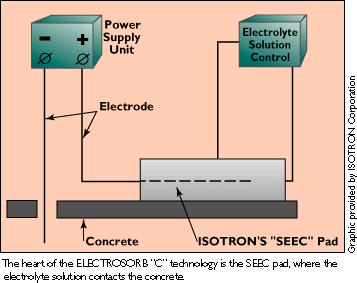

The U.S. Department of Energy estimates there are 600 million square feet of concrete in need of decontamination across the DOE complex. ISOTRON Corporation has developed a decontamination technology that uses electrokinetics and a carpet-like pad to remove contaminants from concrete without damaging it. ISOTRON's ELECTROSORB "C" ("C" for concrete) technology offers an alternative to physical abrasion for cleaning up contaminated concrete. Abrasion creates airborne contaminated particles that must be contained to protect workers. Because the technology doesn't create dust, ELECTROSORB "C" can be operated near other activities without disturbing them. The secondary waste generated by ELECTROSORB "C" is contained in the electrolyte solution and ion-sorbent materials, such as ion-exchange media, which can be safely and easily disposed of.
How it works
ELECTROSORB "C" is a new application of an existing technology that uses electrokinetics to remove ionic contaminants from porous concrete. Using electrokinetics for ground water and soil remediation is fairly common, but using it with solids is unique. Electrokinetics uses an electric field to move ionic contaminants, such as radionuclides, from one place to another. In this case, the contaminants move from the concrete to the heart of the system, the carpetlike Surface Electrokinetic Extraction Concept pad.

A negatively charged electrode is drilled into the concrete, and an electrolyte solution is brought into contact with the concrete through the positively charged SEEC pad (see illustration). The solution contains complexants, chemicals that promote binding of several contaminants. After the contaminants and complexants bind, they are drawn to the electrode in the SEEC pad and are removed. Using complexants allows the electrode to remove more than one contaminant at a time, rather than changing the setup of the electrode for different contaminants.
When the electrolyte solution--now loaded with contaminants--reaches the SEEC pad, it is pumped to a separation module. The contaminants are separated and collected in a disposable cylinder or an ion-exchange medium. The cylinder or exchange material can be treated or disposed of through conventional means. The electrolyte solution picks up more contaminants as it re-circulates to the SEEC pad. Some contaminants stay in the SEEC pad, but the pad can also be disposed of using current technologies.
Testing
ELECTROSORB "C" is a project in DOE's decontamination and decommissioning focus area. The technology was tested in 1994 and 1995 at DOE's Oak Ridge National Laboratory on one-square-foot concrete pads. The test was used for optimizing the electrolyte chemistry used in ELECTROSORB "C." Results from the test showed that the technology was capable of removing uranium from concrete.
ELECTROSORB "C" was also demonstrated June 17Ð28, 1996 in Building 21 at DOE's Mound Facility in Ohio. The prototype SEEC pad was introduced at the Mound demonstration. The testing at Mound showed that ELECTROSORB "C" can remove thorium contaminants from concrete. An independent Mound contractor confirmed the results through pre- and post-treatment characterization.
Through the testing at Mound, ISOTRON scientists found ways that the SEEC pad could be improved. Upgrading the pad involves using improved materials in the positively charged electrode and optimizing the electrolyte solution flow pattern. Replacing the electrode rod that penetrates the concrete with a positively charged SEEC pad is being investigated. Using a second SEEC pad would eliminate concrete penetration completely, farther reducing secondary waste generation. The technique for secondary waste volume reduction and solidification, as well as the process for recycling the electrolyte solution, has been improved since the Mound testing.
ISOTRON is seeking to license the ELECTROSORB "C" technology to companies interested in cleaning up DOE sites. For more information on ISOTRON and its electrokinetics technologies, call Henry L. Lomasney at (504) 254-4624, or e-mail him at clamasney@attmail.com.